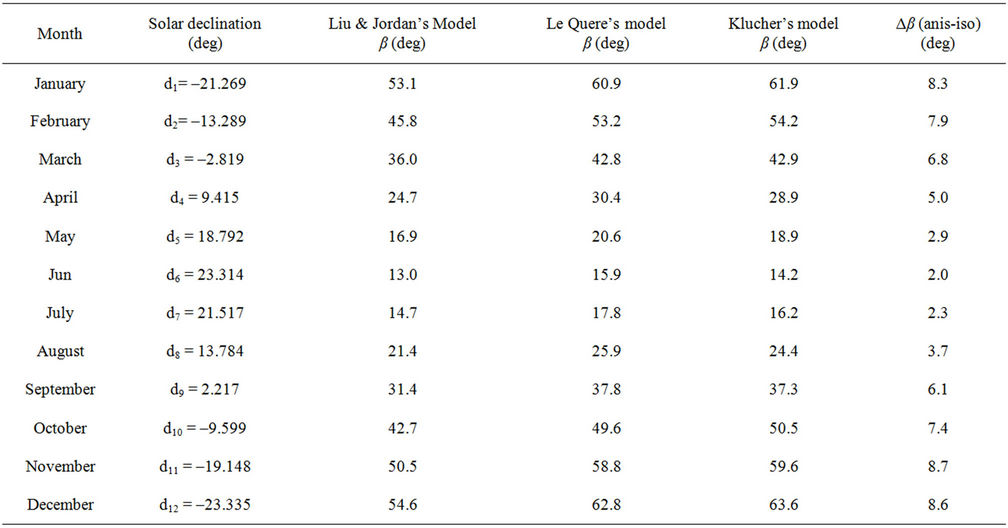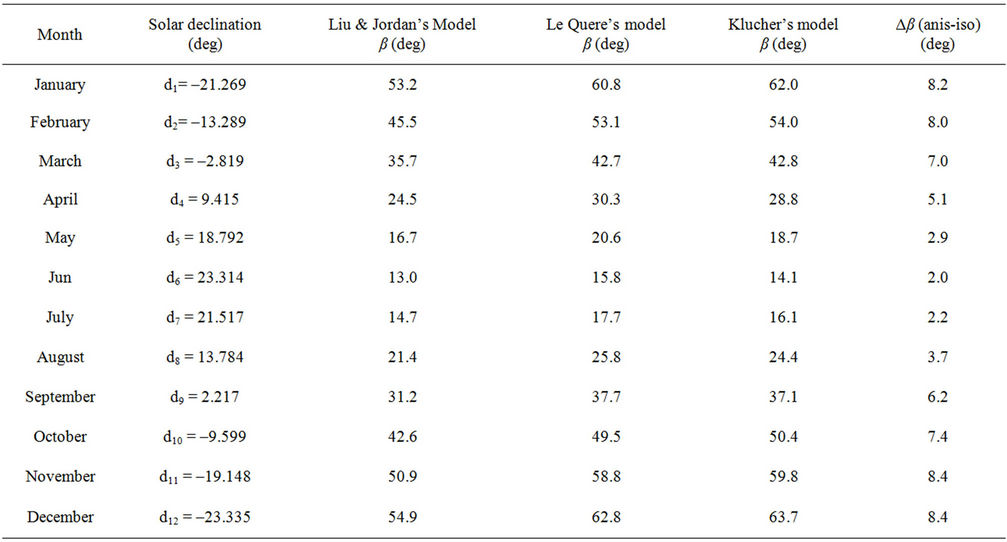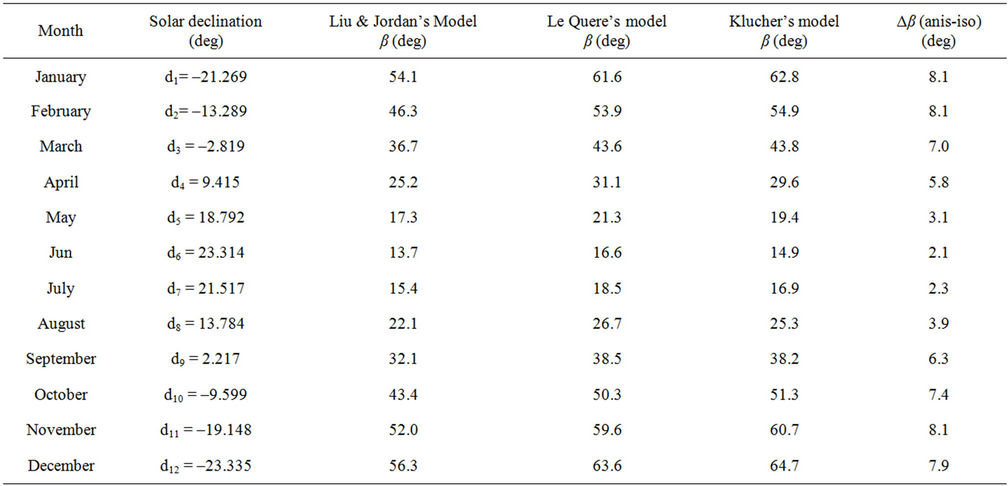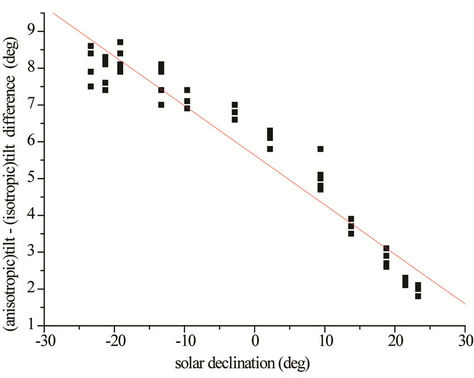Smart Grid and Renewable Energy
Vol.3 No.4(2012), Article ID:24320,7 pages DOI:10.4236/sgre.2012.34035
The Disagreement between Anisotropic-Isotropic Diffuse Solar Radiation Models as a Function of Solar Declination: Computing the Optimum Tilt Angle of Solar Panels in the Area of Southern-Italy
![]()
Department of Physics, University of Messina, Messina, Italy.
Email: e.calabro@yahoo.com
Received September 10th, 2012; revised October 10th, 2012; accepted October 17th, 2012
Keywords: Global Solar Radiation; Diffuse Solar Irradiance; Isotropic Model; Optimum Tilt Angle; Solar Panel
ABSTRACT
In this paper a simulation to maximize the global solar radiation on a sloped collecting surface was applied to typical latitudes in the area of southern Italy, to calculate the optimum tilt angle of solar panels on building structures or large photovoltaic power plants located in that geographical area. Indeed, the area of southern Italy and in particular Sicily and Calabria are the top of European locations for acquiring solar energy. Some models of diffuse solar irradiance were taken into account to determine panels inclinations that maximized the impinging solar radiation by means of global horizontal solar radiation data provided from the Italian Institute of ENEA (Italy). An algorithm was used for the simulation providing a set of tilt angles for each latitude. The optimum tilt angle values obtained from the simulation resulted to be strictly related to the model of diffuse solar radiation that was used. Indeed, the disagreement between the values obtained using anisotropic models of diffuse solar radiation and those obtained from the isotropic model resulted to decrease significantly with increasing solar declination, showing that the isotropic model can be reliable only in summer months.
1. Introduction
The rising cost of electricity has provided the motive for making best use of daylight, and utilization of solar radiation has led to new architectural developments.
As a consequence of the absence of adequate measured solar irradiation data, building designers have to rely on predictive tools and models. These models should be capable of accurately predicting slope and orientation of solar panels to maximize solar energy collectable from meteorological parameters such as global horizontal solar radiation as an input parameter.
The assumption of isotropic diffuse irradiance of [1] for computing optimum tilt angles of solar panels and vertical surface energy gains may have contributed to overestimations.
Hence, during the past decade several new and better solar radiation algorithms have evolved. For example, these models have confirmed that the isotropic assumption overestimates the energy transmission through fenestration by as much as 40% for vertical surfaces.
While modeling and simulation of energy systems would require determination of hourly horizontal and slope quantities, daily and monthly-averaged irradiation values would suffice for an abbreviated analysis.
The area of southern Italy and in particular Sicily and Calabria are the top of European locations for acquiring solar energy, because over 3000 hours of sunshine a year.
In 2009, Sicily was the first European region as it has been reached grid-parity, i.e. the parity between the cost of solar electricity and that produced by burning oil or natural gas. Every kilowatt of installed power generates in Sicily over 1500 kWh per year; 15 solar plants have been surveyed admitted to the incentives, for a total of 177.5 kW, and there is also provided other 1130 facilities (26 of which more than 50 kW) for a total of 45.307 kW.
However, the potential of these regions for the use of solar energy could be even more valued.
This work has been focused on calculating global solar irradiance and optimum tilt of solar panels at some typical latitudes in the area of southern-Italy, using some diffuse solar radiation models and highlighting the disagreement among their results.
Global horizontal solar irradiation have to be preferred with respect to empirical expression such as that of [2]. Hence, data archive of ENEA from 1995 to 1999 have been used.
Otherwise, daily extraterrestrial radiation on a horizontal surface, named Ho, can be computed for day n from the following equation [3]:
 (1)
(1)
where Gsc is the solar constant, equal to 1367 W/m2, n is the number of the day, d the solar declination, j the geographical latitude, and ωs the hour angle of sunrise.
The ratio of solar radiation at a surface of the earth to extraterrestrial radiation is called the clearness index. The monthly average clearness index, Kt, is defined as:
 (2)
(2)
where  is the monthly average daily solar radiation on a horizontal surface.
is the monthly average daily solar radiation on a horizontal surface.
The global horizontal solar irradiation Hg includes the horizontal direct beam irradiation Hb and the horizontal diffuse sky irradiation Hd.
For obtaining solar irradiation on a tilted surface, users must use some predictive slope irradiation models, that evaluate the relationship between the global solar irradiation on horizontal planes and that on tilted planes [1,4-6].
Direct beam and diffuse components of solar radiation can be estimated from empirical relationships by means of clearness index Kt.
The main cause of error in the computation of the optimum tilt and orientation of a solar panel is related to considerable disagreements within the set of those relationships.
The origin of such disagreements depends upon what the diffuse correlation is used for.
The Italian Institute of ENEA (Italy) recommended the following correlation for Italian latitudes:
 (3)
(3)
derived from measures of solar irradiance performed by the ENEA.
2. Empirical Models of the Diffuse Solar Irradiance
Global daily solar radiation on a tilted surface can be estimated as follows:
 (4)
(4)
where Ib is the direct radiation, which emanates from the solar disk, Id the diffuse radiation, which emanates from the rest of the sky, and Ir the ground reflected radiation.
The daily beam radiation on a tilted surface Ib can be obtained by means of the ratio of the average daily beam radiation on a tilted plane to that on a horizontal plane, named Rb, and the parameters to it correlated:
 (5)
(5)
The evaluation of the ground-reflected diffuse irradiance is dependent on the factor Ir. Most studies consider that the ground reflection process is ideally isotropic [1], in which specific case Ir can be simplified into
 (6)
(6)
where ρ represents the ground albedo, and β is the slope of the panel as to the horizontal plane.
If we assume an isotropic distribution of solar radiance through the sky, the diffuse irradiance can be expressed as follows [1]:
 (7)
(7)
The assumption that the diffuse radiation originates entirely from the solar disk gives the relation
 (8)
(8)
that is the modeling opposite to the isotropic of [1].
Nevertheless, absorbing and scattering processes in the atmosphere redistribute solar energy out of the direct beam into the diffuse radiation.
Le Quere [7] proposed a model for the diffuse solar component as a combination of the two components,
 (9)
(9)
suggesting the value F = 0.8, while Hay and Davies assumed the ratio of terrestrial direct radiation to extraterrestrial radiation as the degree of anisotropy (1 – F).
Klucher [8] proposed a model where the isotropic component Id(iso) is multiplied by two factors that represent both circumsolar and horizon brightening:
 (10)
(10)
In this expression the parameter K expresses the degree of anisotropy as a modulating function of the amount of direct radiation received by the surface
 (11)
(11)
Further models have been proposed up to now to perform the anisotropy of diffuse solar irradiance, by means of some coefficients based on statistical analysis of empirical data for specific locations.
The peculiarity of PV systems is that they can use both forms of radiation, direct and diffuse irradiation, hence further empirical researches on expressions of diffuse solar irradiance need to optimize the solar energy collected by a solar panel.
3. Computing the Optimum Tilt Angle Relative to Different Diffuse Solar Radiation Models at Typical Latitudes in the Area of South-Italy
The global horizontal solar radiation data relative to 5 cities in the area of southern Italy (Messina, Palermo, Catania, Reggio Calabria, Lamezia Terme) provided from the Institute of ENEA from 1995 to 1999 were used. The geographic latitude and longitude of the cities are indicated in the Tables 1-5.
Daily extraterrestrial radiation on a horizontal surface, Ho, was computed from (1), and Equation (3) was used as the relationship between Hd and Hg.
Ground albedo was fixed at the typical value ρ = 0.20, corresponding to the cement.
The isotropic model of [1] and the anisotropic models of [7,8] were used to calculate the diffuse solar component Hd.
The optimum tilt angle values β were calculated using the parameters of the cities and the models of diffuse solar radiation above mentioned. The computation was performed using the algorithm proposed in [9] based on the assumption that the daily solar irradiation impinging on the collecting surface be maximum with respect to the angles β, γ, ω, where β is the slope of the panel as to the horizontal plane, γ is the azimuth, ω the solar hour angle, respectively.
This physical assumption is represented by the mathematical conditions:
 (12)
(12)
 (13)
(13)
 (14)
(14)
The set of equations can be solved as to the angles β, γ, ω, using numerical methods [9].
The use of the isotropic model of [1] provides the solutions:
 (15)
(15)
 (16)
(16)
 (17)
(17)
The use of the anisotropic model of solar diffusion radiation of [8], instead, provides a set of equations that cannot be solved analytically with respect to β, γ, ω, but only using iterative methods, as accurately described in [9].
The optimum tilt angle values that were calculated using the models above mentioned are reported on the Tables 1-5 for each latitude.
The corresponding monthly average of the daily global solar radiation can be considered representative of the conversion efficiency of a PV module, because it has a linear relationship with the solar radiation rate [10].
The optimum tilt angle values obtained for winter months were confirmed to be very different from the values relative to summer months at each latitude, confirming that a seasonal tilt angle adjustment is needed, such as it was evidenced by [11] for some European cities.
Furthermore, the disagreement between the optimum tilt angle values obtained using the two anisotropic models of diffuse solar radiation resulted lesser than 2 degrees for each latitude and solar declination value.
In contrast, the disagreement between the optimum tilt angle values obtained using the anisotropic models and those obtained using the isotropic model resulted relevant for the winter months, as can be observed in the last column of the Tables 1-5, where the differences Δβ between the averaged optimum tilt angles obtained from

Table 1. Optimum tilt angle values computed using the diffuse models of Liu and Jordan, Le Quere, and Klucher, and the monthly averages of the daily global horizontal solar irradiation data acquired from 1995 to 1999 by the ENEA at the site of Messina (latitude +38˚11'40", longitude +15˚33'02"); di (i = 1 ··· 12) is the solar declination computed for the 15th day of the i-month. The difference between the mean of the optimum tilt angle obtained by means of the anisotropic models and the value obtained using the isotropic model is reported for each solar declination in the last column.

Table 2. Optimum tilt angle values computed using the diffuse models of Le Quere, Hay and Davies, and Klucher, and the monthly averages of the daily global horizontal solar irradiation data acquired from 1995 to 1999 by the ENEA at the site of Palermo (latitude +38˚06'44", longitude +13˚20'12"); di (i = 1 ··· 12) is the solar declination computed for the 15th day of the i-month. The difference between the mean of the optimum tilt angle obtained by means of the anisotropic models and the value obtained using the isotropic model is reported for each solar declination in the last column.

Table 3. Optimum tilt angle values computed using the diffuse models of Le Quere, Hay and Davies, and Klucher, and the monthly averages of the daily global horizontal solar irradiation data acquired from 1995 to 1999 by the ENEA at the site of Catania (latitude +37˚30'05", longitude +15˚04'27"); di (i = 1 ··· 12) is the solar declination computed for the 15th day of the i-month. The difference between the mean of the optimum tilt angle obtained by means of the anisotropic models and the value obtained using the isotropic model is reported for each solar declination in the last column.

Table 4. Optimum tilt angle values computed using the diffuse models of Le Quere, Hay and Davies, and Klucher, and the monthly averages of the daily global horizontal solar irradiation data acquired from 1995 to 1999 by the ENEA at the site of Reggio Calabria (latitude +38˚06'42", longitude +15˚39'44"); di (i = 1 ··· 12) is the solar declination computed for the 15th day of the i-month. The difference between the mean of the optimum tilt angle obtained by means of the anisotropic models and the value obtained using the isotropic model is reported for each solar declination in the last column.

Table 5. Optimum tilt angle values computed using the diffuse models of Le Quere, Hay and Davies, and Klucher, and the monthly averages of the daily global horizontal solar irradiation data acquired from 1995 to 1999 by the ENEA at the site of Lamezia Terme (latitude +38˚58'01", longitude +16˚18'36"); di (i = 1 ··· 12) is the solar declination computed for the 15th day of the i-month. The difference between the mean of the optimum tilt angle obtained by means of the anisotropic models and the value obtained using the isotropic model is reported for each solar declination in the last column.
the two anisotropic models and the values resulted from the isotropic model were reported.
This difference was plotted as a function of solar declination, using all the optimum tilt angle values obtained from the simulation and reported in the tables (see Figure 1).
A significant correlation was found, represented by a correlation coefficient R = 0.965 (the linear regression is represented by the red line in Figure 1).
This result showed that the isotropic model at latitudes in the range from 37˚ to 39˚ can be reliable only in the months from May to August, suggesting that further research is needed on empirical models of diffuse solar radiation depending on the geographic location.
4. Conclusions
The maximization of global solar radiation on an inclined surface applied to some latitudes in the area of southern Italy led us to use an algorithm to solve a set of equation to provide the optimum tilt angle β of a collecting surface. The numeric simulation was applied to some latitudes in an area of Southern-Italy, using global horizontal solar radiation data provided from the Italian Institute of ENEA (Italy) and some models of diffuse solar irradiance.
The optimum tilt angle values that resulted from the simulation strictly depend on the used models of diffuse solar irradiation.

Figure 1. The difference between the optimum tilt angle computed using the anisotropic models of diffuse solar radiation and the value obtained using the isotropic model, as a function of solar declination. A significant correlation was found, represented by a correlation coefficient R = 0.965 (the linear regression is represented by the red line). All the optimum tilt angle values obtained from the simulation, reported in the Tables 1-5, were used for the plot.
In particular, a relevant disagreement between the optimum tilt angle values obtained using the anisotropic models and those obtained using the isotropic model was evidenced for the winter months. Indeed this difference was observed to decrease with increasing solar declination, with a significant correlation coefficient.
This result, which may be extended to other locations with the same latitudes, showed that the isotropic model can be reliable only in summer months, suggesting the need of further research on empirical models of diffuse solar irradiance depending on the geographic location, to provide the maximization of the solar radiation collectable by a solar collector.
REFERENCES
- B. Y. H. Liu and R. C. Jordan, “The Interrelationship and Characteristics Distribution of Direct, Diffuse and Total Solar Radiation,” Solar Energy, Vol. 4, No. 3, 1960, pp. 1-19. doi:10.1016/0038-092X(60)90062-1
- A. Angstrom, “Solar and Terrestrial Radiation,” Quarterly Journal of the Royal Meteorological Society, Vol. 50, No. 210, 1924, pp. 121-126. doi:10.1002/qj.49705021008
- S. A. Klein, “Calculation of Monthly Average Insolation on Tilted Surfaces,” Solar Energy, Vol. 19, No. 4, 1977, pp. 325-329. doi:10.1016/0038-092X(77)90001-9
- L. Robledo and A. Soler, “Modeling Irradiance on Inclined Planes with an Anisotropic Model,” Energy, Vol. 23, No. 3, 1998, pp. 193-201. doi:10.1016/S0360-5442(97)00083-2
- F. J. Olmo, J. Vida, I. Foyo, Y. Castro-Diez and L. Alados-Arboledas, “Prediction of Global Irradiance on Inclined Surfaces from Horizontal Global Irradiance,” Energy, Vol. 24, No. 8, 1999, pp. 689-704. doi:10.1016/S0360-5442(99)00025-0
- L. Wenxian, G. Wenfeng, P. Shaoxuan and L. Enrong, “Ratios of Global Radiation on a Tilted to Horizontal Surface for Yunnan Province, China,” Energy, Vol. 20, No. 8, 1995, pp. 723-728. doi:10.1016/0360-5442(95)00016-A
- J. LeQuere, “Rapport sur la Comparaison des Methods de Calcul des Besoins de Chauffage des Logements,” CSTB TEA-S 87, CSTB, Paris, 1980.
- T. M. Klucher, “Evaluation of Models to Predict Insolation on Tilted Surfaces,” Solar Energy, Vol. 23, No. 2, 1978, pp. 111-114. doi:10.1016/0038-092X(79)90110-5
- E. Calabrò, “An Algorithm to Estimate the Solar Energy Maximum Collection on Inclined Panels from Global Horizontal Solar Radiation,” International Journal of Sustainable Energy, 2012, Submitted.
- S. Naihong, N. Kameda, Y. Kishida and H. Sonoda, “Experimental and Theoretical Study on the Optimal Tilt of Photovoltaic Panels,” Journal of Asian Architecture and Building Engineering, Vol. 5, No. 2, 2006, pp. 399-405. doi:10.3130/jaabe.5.399
- E. Calabrò, “Determining Optimum Tilt Angles of Photovoltaic Panels at Typical North-Tropical Latitudes,” Journal of Renewable and Sustainable Energy, Vol. 1, No. 3, 2009, Article ID: 033104. doi:10.1063/1.3148272

